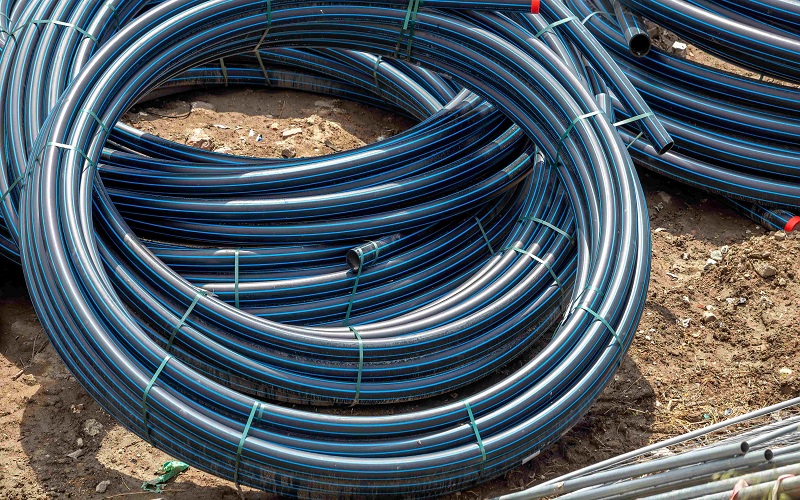High-density polyethylene (HDPE) pipes have become an essential component in various industries, such as agriculture, construction, and municipal infrastructure. They have become a preferred choice for a wide range of applications due to their versatility, durability, and cost-effectiveness. This guide aims to provide a comprehensive understanding of HDPE pipes, their properties, uses, installation methods, and benefits, shedding light on why they are becoming increasingly popular.
HDPE pipe and its benefits
HDPE pipe is a type of flexible plastic pipe made from high-density polyethylene, a thermoplastic polymer known for its exceptional strength, flexibility, and resistance to corrosion and chemicals. HDPE pipes are produced through a process of extrusion, where the polymer is melted and formed into the desired pipe shape.
Below are the numerous advantages of HDPE pipes:
- Durability: This kind of pipe is highly durable and can withstand harsh environmental conditions, including temperature variations, soil movement, and exposure to chemicals.
- Flexibility: They are flexible, allowing for easy installation even in challenging terrain. Their flexibility reduces the need for additional fittings and joints, minimising the risk of leaks. The flexibility also makes them resistant to cracking and breaking under pressure.
- Chemical Resistance: HDPE pipe is suitable for transporting a wide range of fluids, such as water, sewage, chemicals, and slurries, due to its resistance to corrosion and chemical damage. This feature extends the lifespan of the pipe in various environments.
- Lightweight: Unlike traditional materials such as concrete and metal pipes, HDPE pipes are lightweight. This characteristic simplifies transportation, handling, and installation, reducing overall project costs.
- Leak-Free Joints: The fusion welding technique used to join HDPE pipes creates leak-free joints, removing the risk of water or gas leakage. This is crucial in applications where a secure and reliable connection is very important.
HDPE pipe and its applications
HDPE pipes find applications in diverse industries, showcasing their adaptability to different needs. Here are some key sectors in which HDPE pipes are commonly used:
- Water Supply and Distribution: HDPE pipes are extensively used for water supply and distribution systems in urban and rural areas. Their resistance to corrosion and low maintenance requirements make them ideal for delivering clean and potable water to communities. Their flexibility also allows for easy installation on various terrains.
- Subsoil Drainage: HDPE pipes used in subsoil play a crucial role in managing water beneath the ground surface. Often used in agricultural and construction settings, these pipes prevent waterlogging and facilitate proper drainage. HDPE subsoil pipes, with their flexibility and durability, are well-suited for different methods of application, ensuring efficient water management in the subsoil.
- Sewer and Wastewater Systems: HDPE pipes used in drainage systems are essential for the efficient removal of excess water from different areas, preventing waterlogging and potential damage. HDPE drainage pipes are widely used due to their corrosion resistance and leak-free joints. These pipes contribute to effective stormwater management, agricultural drainage, and wastewater systems.
- Industrial Applications: HDPE pipes serve various industrial purposes, such as transporting chemicals, acids, and abrasive materials in industries like mining, chemical processing, and manufacturing.
HDPE pipe and its installation
Depending on the application and project requirements, HDPE pipes can be installed using different methods. Here are some of the methods by which HDPE pipes can be installed:
- Trench Installation: In this method, trenches are excavated to the required depth, and HDPE pipes are laid in the trenches. Proper bedding and backfilling techniques are crucial to ensuring the stability and integrity of the pipeline.
- Horizontal Directional Drilling (HDD): HDD is a trenchless method used for installing HDPE pipes beneath barriers or obstacles such as roads, rivers, and existing infrastructure. It involves drilling a pilot hole along the desired path and then pulling the HDPE pipe through the drilled hole.
- Pipe Bursting: Pipe bursting is a trenchless technique used for replacing existing pipelines with HDPE pipes. It involves breaking the existing pipe while simultaneously pulling the new HDPE pipe into place.
HDPE pipes offer several advantages over conventional piping materials:
- Longevity: Due to its inherent durability, you can be sure of its long service life, reducing the need for frequent replacements and maintenance. This minimises disruptions to operations and saves costs as well.
- Cost-Effectiveness: Despite higher initial costs compared to some traditional materials, HDPE pipes offer significant cost savings over their life cycle due to lower maintenance and repair expenses. Additionally, the lightweight nature of HDPE pipes makes transportation and installation more cost-effective, and their leak-free joints and corrosion resistance contribute to overall cost savings over time.
- Environmental Sustainability: HDPE pipes are recyclable and environmentally friendly. They can be melted down and reprocessed into new products, minimising waste and reducing the carbon footprint.
- Versatility: They are available in a wide range of sizes and pressure ratings, making them suitable for diverse applications across different industries.
Wrapping it up
HDPE pipes have emerged as a preferred choice for water supply, drainage, and industrial applications because of their exceptional properties, versatility, and cost-effectiveness. Understanding the properties, uses, and installation methods of HDPE pipes is essential for engineers, contractors, and decision-makers involved in infrastructure projects. By harnessing the benefits of HDPE pipes, you can build resilient and sustainable systems that meet the evolving needs of modern society.

